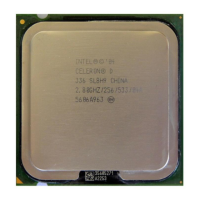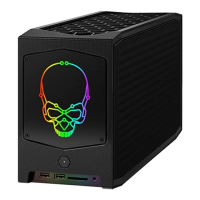Acoustic Fan Speed Control
R
Thermal/Mechanical Design Guide 55
6.3 Board and System Implementation
Once the thermal solution is defined, the system designer and board designer can define the fan
speed control implementation. The first step is to select the appropriate fan speed controller
(FSC).
Figure 17 shows the major connections for a typical implementation.
Figure 17. Example Acoustic Fan Speed Control Implementation
HS Fan
Processor
Fan Speed
Controller
Pulse Width
Modulation (PWM)
Tachometer
Thermal Diode
(2 wires)
+12V
GND
Sys
Ambient
(Opt)
Sys Fan
4wire
PWM
(2x)
T
CONTROL
BIOS
Inlet Ambient
(Thermistor)
4-Pin Fan
Header
HS Fan
Processor
Fan Speed
Controller
Pulse Width
Modulation (PWM)
Tachometer
Thermal Diode
(2 wires)
+12V
GND
Sys
Ambient
(Opt)
Sys Fan
4wire
PWM
(2x)
T
CONTROL
BIOS
Inlet Ambient
(Thermistor)
4-Pin Fan
Header
A number of major manufacturers have FSC components that include the necessary functionality
to measure the temperature of the on-die thermal diode and output a PWM signal. These
components can be a discrete device or a super I/O (SIO) with the functionality embedded. The
following vendors currently have components that could be suitable: Analog Devices, ITE,
Maxim, National Semiconductor, SMSC and Winbond. Consult their web sites or local sales
representatives for a part suitable for your design. See
Appendix E for further details on the
motherboard requirements
6.3.1 Choosing Fan Speed Control Settings
Fan speed control algorithms allow the system thermal engineer a number of options to consider.
The typical control settings that need to be considered are:
• The temperature when the fan will begin to accelerate in response to the on-die thermal diode
temperature (T
LOW
)
• The temperature where the fan speed is operating at full speed (100% PWM duty cycle). By
specification this is T
CONTROL
• The minimum fan speed (PWM duty cycle). For any on-die thermal diode temperature less
than T
LOW
the fan will run at this speed
These are the minimum parameters required to implement acoustic fan speed control. See
Figure 18 for an example. There may be vendor specific options that offer enhanced functionality.
See the appropriate vendor datasheet on how to implement those features.

